First off, congratulations on finding such a wonderful person! Only the people getting engaged can really make decisions about this, together, because engagement (or enGAYgement) is a super personal thing. It’s different for everyone! So I’ll tell you what I did when I started shopping for engagement rings for my fiancée.
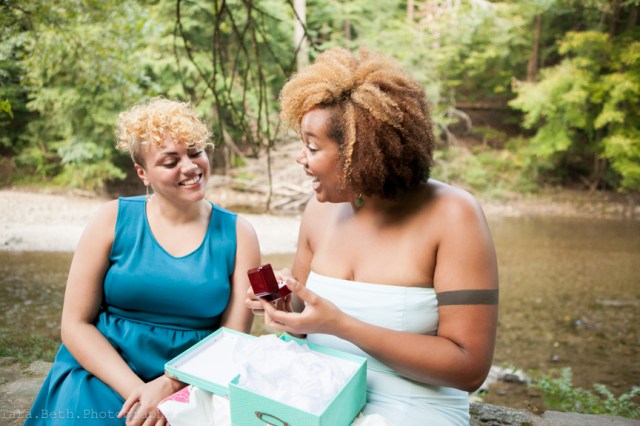
How Do You Start Looking?
Originally, I had my fiancée start making a Pinterest board. I did this because we’d already decided we wanted to get married. We’d already had The Talk about how we wanted that to look — and one of the things we talked about was that we wanted to have a wedding and we wanted a fairly traditional (if on the longer side) engagement, complete with a ring. We agreed on all of that fairly instantly. Where we didn’t agree at first was how that ring would be decided on. I was going to be doing the proposing (something that was important to both of us), and I insisted that everything about the proposal should be a surprise. Not just how I asked or where, but the ring as well. That made sense to me — I love surprises and spontaneity. But I still wanted to get the ring right — I wanted it to be something my fiancée would love. So she made a face about the surprises thing (she does not like surprises) and started pinning things to the Pinterest board.
And thank lesbian Jesus we did that, because I might never have realized that I was completely and totally wrong to insist that I pick the ring if we hadn’t. I took a look at the Pinterest board for the first time and holy unicorns, I could not see one damn thing in common between all the rings she picked! It’s like there’s no line that could possibly be drawn through them all. Just about the only thing similar about each piece is that they were all jewelry. So then I got to thinking — maybe surprises are good for some couples, but clearly that wasn’t going to work with us. I wondered where I’d gotten the impression that the ring had to be a total surprise, with only one partner in on it. Oh yeah. That’s right. Traditional straight engagement. Well we’re neither traditional nor straight, so I relented and we started shopping together.
Let me tell you. I highly recommend it, shopping together. First, it’s a bonding experience. Picking an engagement ring together leads to all sorts of other conversations about your future: where you want to live, what you want your careers and families to look like, what do you want out of a wedding and out of a marriage? It becomes a conversation, an opportunity to go out for lunch after visiting a jeweler and just chill and chat. Engagement ring shopping is the most productive date! Second, it takes the pressure WAY off you. You know exactly how she feels about this ring or that, solitaire versus engagement band, diamond versus moissanite. When I tell people this, their first concern seems to be that my fiancée then knew how much I was spending. GASP! Whatever shall we do about the etiquette of gift giving?? GRAB YOUR PEARLS AND HEAD FOR THE HILLS. But we were living together at the time. We had a joint checking account. We were planning our financial future (and present) together — if I was going to spend an amount, she was going to know what amount that was anyway. I found it to be more responsible of both of us if we had a budget talk.
So let’s talk about how to go about actually looking at real, physical rings that you can hold in your hand. Sure, you can go to something like a Kay Jewelers or Jared — we really didn’t want to do that. Both of us have really complex diamond feelings and wanted ethically-sourced gem stones (perhaps not a diamond at all). We wanted to know that the jeweler, the person really responsible for making the ring, was getting paid most of what we were spending (not some big corporation or parent company or whatever). We also wanted to support small businesses and know that we were putting our dollars into a business that supports marriage equality. Bonus, we also found a jeweler run by women. Now that’s not to say you have to do the same — if both of y’all have found the perfect thing right in your budget and it happens to be at a big box retailer, you should get that thing. Everyone is different.
But here’s why I at least recommend looking at some smaller jewelers — many jewelers can work within a budget you give them (and if they can’t, they’re going to be really upfront with you about it). They can give you all sorts of information about what costs are worth cutting and what’s worth splurging on. And the really good ones won’t try to up-sell you because some corporation tells them to; they’re going to make sure you, the two people standing in front of them, are happy with your choice. They’re going to ask you questions to find out what you value and they’re going to suggests tweaks to the ring you found on the website based on the things you tell them. They’re going to get really excited with you when you finally purchase. And all of those “there’s so many options” feelings will start to dissipate when you have your own Willy Wonka guiding you through the chocolate factory. They’ll teach you the words for the styles that you like (oh, so that’s what “cushion cut” means), so that you can speak about them in future. Really excellent jewelers do those things and so much more.
If you’re curious, our really excellent jeweler is Bario Neal, run by two women with a studio in Philadelphia and a showroom in New York. From their about page:
As a small company, we have the freedom to innovate according to our design vision and our ethical commitments. We use this flexibility to try out new materials and sources, branch into new projects that reflect our evolving interests, and advocate for both global and local causes. We donate a percentage of our profits to many environmental and social justice organizations in whose missions we strongly believe, including Ethical Metalsmiths, EarthWorks, Freedom to Marry, Human Rights Campaign, and Planned Parenthood. Locally, we support Delaware Riverkeeper’s efforts to prevent fracking, as well as being actively engaged within our community, particularly the Philadelphia public schools.
Everything they do is handmade. They are magic people. We plan to get our wedding bands through them, too.
If you’re anything like us, you might go sit in a park the first time you look at your first jeweler in person and breathe deeply over and over again, repeating “that’s the most adult thing we’ve ever done.” Or not. Getting married doesn’t make you an adult, and not getting married doesn’t make you not an adult.
When you’re beginning this phase, know that some jewelers allow walk-ins, and others require consultation appointments. Don’t feel weird about making those appointments: the jewelers know that you’re shopping around and aren’t going to expect you to purchase anything on your first trip. If they do expect that of you, that’s really weird and you still shouldn’t feel any obligation.
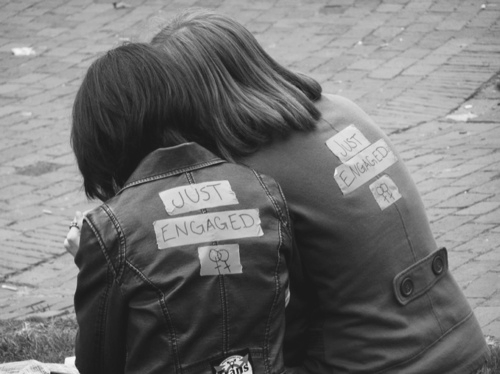
How Do You Start Saving?
Yep, engagement rings cost money. No matter your budget, they still cost money. And no matter what we hear from other people (we’ll get to some things you should ignore later), you should go into this with a budget that is realistic to you and your own financial circumstances.
What I did was put money aside in a savings account that I dedicated just for this. I recommend this, because it leaves you with a sense of accomplishment — you can see the money build up. And if you grab an interest-yielding, FDIC-insured savings account, you can keep that around to save for other things in your life once you’re done purchasing the engagement ring. Now how much you stick in the account is, obviously, completely up to you. Pro tip: when you’re ready to purchase and you have the entire amount tucked in a savings account, put the ring on your credit card and then immediately pay the entire ring-amount the same month. Nothing says romance like a boost in your credit score.

How Do You Actually Purchase The Thing?
There are a few things you need to know regardless of whether your future-fiancée is coming with you for the actual purchase.
- Make sure you know if she’s allergic to any metals.
- Make sure you know her ring size.
- And then anything else you may have discussed about rings (this is where the joint shopping trips you took before come in handy).
In my case, we did go purchase the ring together. I already had all the elements of the ring written down — what the setting looked like, what kind of stone it was going to be, what kind of metal we’d decided on — so it wasn’t really necessary to have her come along. But while we were still in the shopping phase, we discovered a really good crêperie across the street, which meant that every single time we went to Bario Neal, we also took ourselves out on a date. So because my fiancée was there, we could get her sized right on the spot. This turned out to not make any difference, by the way, because apparently one doesn’t know how a ring will actually fit until one wears it in their real life. Make sure to check with your jeweler that they’ll do a free or cost-effective resize if the size is wrong the first time.
It might not be worth saying, but you probably won’t take the ring home that day (it’s not like how it is in the movies). If any element of the ring is custom made, or even if they have to resize something you’ve picked that’s already made (or vintage!), someone will have to actually perform an act of artistry on your ring. For us, that took six weeks. Which was obviously preferable, because in six weeks we had a hankering for crêpes again. She came with me to pick it up, too, and eat crêpes.
Here is what we decided on, though — my fiancée couldn’t see the ring when we picked it up. It went right in my pocket and that was the last she saw of it before I proposed to her (a thing I tried and failed to make a surprise, but that’s a story for another day). You might decide differently — your fiancée might put that ring on right then and there, at which point y’all will declare yourselves engaged and go out to dinner. My point here is that you have to talk to each other about what your expectations are in this respect.
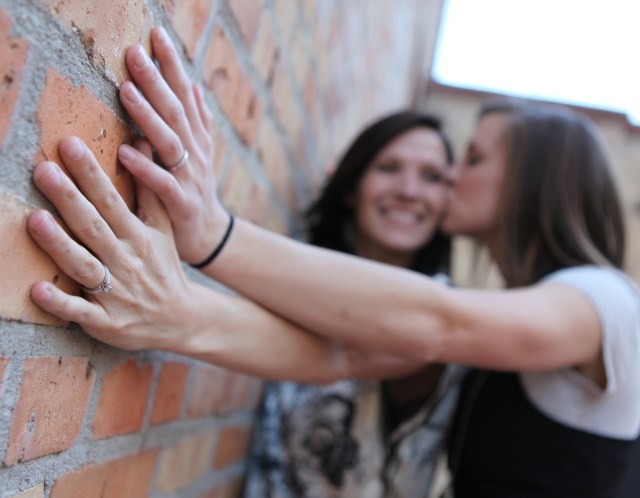
A Few Things You Should Ignore
Having written for wedding magazines in the past, I am deeply familiar with a little thing called The Wedding Industrial Complex. Weddings are a huge money maker, and they’re getting more and more elaborate each passing year. There is so much pressure and marketing surrounding weddings, and surrounding engagement rings in particular. Here are just a few things I can think of that people get really weird about for no reason other than tradition (a tradition, by the way, that’s just not that old) and the skill of advertisers. I am giving you permission to ignore these things. I know, I’m just some dyke writing this in her living room, but sometimes you just need permission to say fuck it and do what you actually want. If anyone asks you why you and your fiancée didn’t adhere to any of the following “rules,” y’all can just say Autostraddle told you it.
1. A ring should cost three months salary.
Lolololol x infinity. Yeah fucking right. I’m a writer and a graduate student, we’d prefer to eat and pay rent, thanks. But you know, this is actually some 1950’s holdover bullshit that actually still gets said with people’s mouths in the real world. Ignore any etiquette pronouncements about your budget. You and your partner know what you can afford and what you want to spend — sometimes people get confused because “you can afford it.” But that doesn’t mean a piece of jewelry is where your priorities lie. Maybe you choose the way you do and then go on vacation. Or just tuck it away for later, when you think of something you’d rather do with it than buy a big honking diamond. Which reminds me —
2. A ring has to have a diamond in it.
Not so. It was important to my fiancée that the ring fit the current cultural conditions of an engagement ring because part of the fun of it is playing on the jungle gym that is societal milestones. But for us that didn’t mean a diamond — both of us had really squirmy feelings about the ethics of diamonds. We knew going in that if we were going to use a diamond, it would be a vintage resetting (creating no new demand) or we were going to use another clear stone that wasn’t quite so fraught. We chose that latter because moissanite is made from space rocks and that was one million times cooler to us than crystallized dinosaur goo. Just because it was important to us that the ring have a clear stone in it, though, doesn’t mean it has to be important to you. My mother’s engagement ring had an emerald in it instead.
3. An engagement ring should be a ring.
I don’t have an engagement ring that I wear. Let me tell you a bit about that.
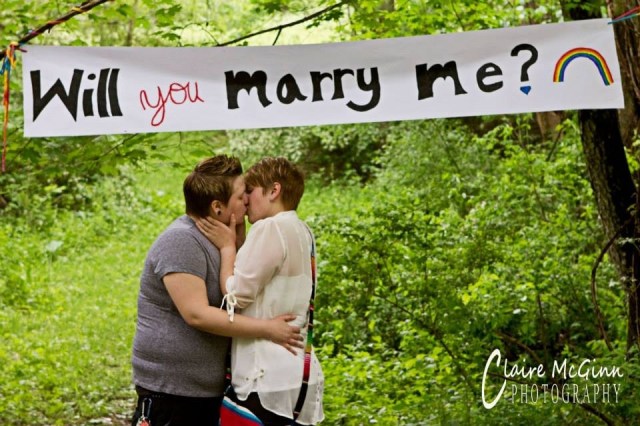
Thinking Outside The Ring Box
I don’t wear rings. I did once, but I don’t now. While I plan to wear a wedding band, an engagement ring was just a bit too feminine for my current style. But it was really important to both of us that our engagement symbols be reciprocal: it seemed really weird and territorial for the more masculine of the two of us to put a ring on the more feminine one’s finger and have that be the end of the tradition we were starting for the two of us. So we thought about other fun things I could wear instead. The most everyday wearable thing we came up with was a watch, especially after it came out that I didn’t own a working watch. We started looking and I had a Victorianox one picked out. But life has other plans.
My cat got cancer, which he ultimately died from. His medical bills were high. Our budgets changed. We decided to hold off on the watch in order to be fiscally responsible people, and I wound up proposing to her with the ring we picked out and having no intention of receiving something in return. But we were walking through Provincetown the day after and we spotted a watch in the window. Both of us saw it at relatively the same instant and both of us thought the exact same thing. It was gorgeous. It was in our budget. We went it and bought it from the (lesbian, we’re guessing) shopkeeper. And then we found a patch of sand in the vicinity of the shop to stand on and she proposed to me right back with the watch. It was perfect. Not what we planned, and not what people see as traditional, but it was perfect for us.
I think what I’m getting at by telling you this story is that, in a way, it is easier to break the fake rules as queer people. Legal gay marriage is a relatively new thing, at least in the U.S. While commitments have been happening forever, there were far fewer fossilized or advertised “traditions” surrounding that. So being that our traditions are somewhat less rule-based and that we have comparatively fewer engagement role models than straight people do, people almost expected my fiancée and I to do something a little bit on the weirder side. Not one straight person has made any negative or confused comments about my watch or about the unique design of my fiancée’s ring (the only pushback at all we’ve gotten to our engagement, actually, comes from other queer people, but that’s an essay for a different day). We don’t have to follow tradition because we seem to be inherently less traditional. That’s a really powerful place to be. So make your own traditions. Make an engagement, and later a marriage, that makes sense to and for the both of you. Don’t worry about making sense to the Complex.
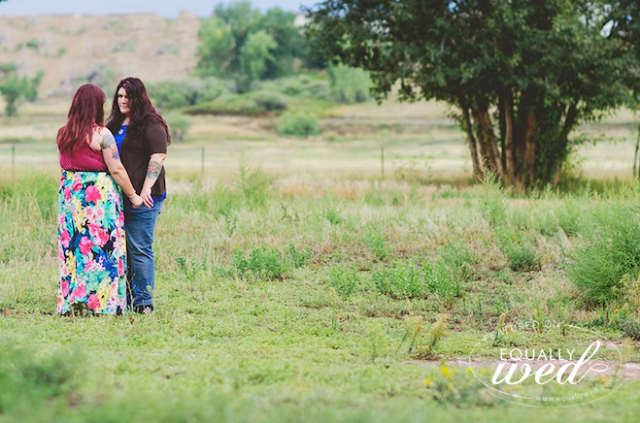
Some Questions to Help You
Okay, so really boiling my experiences down to something helpful — let’s talk about some questions you can ask your sweetheart to decide how to proceed here. This is what I recommend:
1. Is marriage your thing?
2. When would you like to be asked, do you think? Two years in? Two years from this point right now?
3. Do you want a traditional engagement?
4. Do you want a ring? Or something else?
5. Do you want the ring (or the something else) to be a surprise? If so, how would you like me to shop for you? What kinds of questions may I ask? If not, how involved do you want to be in the shopping process?
6. If we are going to shop together, what is important to you about that process?
7. What do you want out of a proposal? Who should propose first, if that’s what we’re going to do? Do you want the proposal to be a surprise? Public? Private? (Example: my fiancée would have run screaming if I’d involved anyone other than the two of us in our proposal.)
8. What kinds of engagement traditions are important to you and/or your family? What traditions are just not your thing or don’t matter to you? How do they fit with my expectations for engagement rings and engagement?
And there you are, on your way to one of the coolest, most edifying conversations you’re gonna have — that is, until you start talking about your wedding and your marriage.







